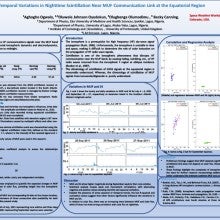Temporal Variations of Nighttime Scintillation Near the MUF Communication Link at the Equatorial Ionization Anomaly
Dr. Ogwala
Aghogho
Eko University of Medicine and Health Sciences, Lagos, Nigeria
Poster
Scintillation is a phenomenon caused by ionospheric irregularities that disrupt the propagation of High Frequency (HF) radio communication signals, including those near the Maximum Usable Frequency (MUF) band. This effect is particularly pronounced in the equatorial region due to the Equatorial Ionization Anomaly (EIA) and at high latitudes due to auroral activities. The variability of scintillation near the MUF is influenced by ionospheric dynamics and electrodynamics, particularly from post-sunset to midnight. This study examines the relationship between the Maximum Usable Frequency (MUF) and scintillation (S4) index to assess the potential correlation between these parameters over time. Results of our preliminary analysis reveals weak and inconsistent correlations between both parameters, with alternating negative and positive values depending on the month and year. Some other interesting results have also been noted due to the significant influence of the variations in MUF and S4 index.

Poster PDF
Poster category
Ionosphere and Thermosphere Research and Applications
Meeting homepage